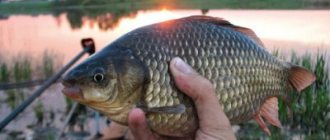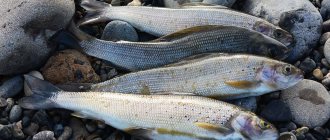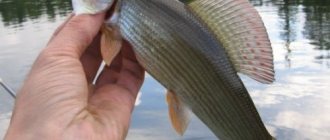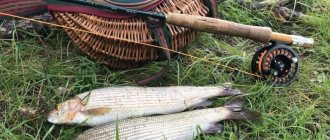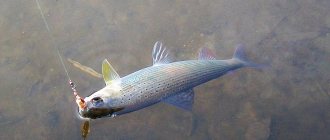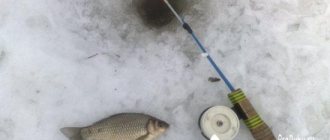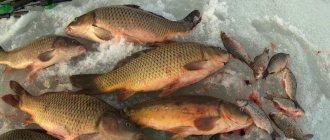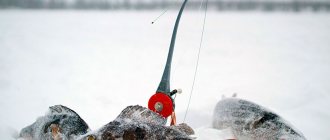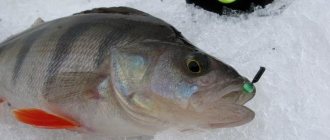Grayling fishing in winter is often characterized as difficult and unpromising. This northern inhabitant of the salmon family is not found everywhere (usually Siberia, Komi), preferring large rivers with fast currents and cold water. It is valued for its high taste. The average weight of a predator is about 1 kg, but larger specimens can be found - up to 3 kg. For winter fishing for grayling to be both exciting and productive, you need to know where to look, how it behaves during this period, and what it is caught with.
Features of winter grayling fishing
Grayling is an active fish. After ice forms on a body of water, before ice drift, it can even approach the very shore, rifts and stay almost at the very edge of the ice. But when the weather gets really cold, it prefers to sit in pools, holes, next to which there is a current. This condition is mandatory. Grayling, with all its activity and swiftness, does not really like to pursue prey for a long time. The current that brings food does this for him.
On clear weather days the main bite occurs in the morning and evening. If the weather is cloudy, then grayling can bite throughout the daylight hours. In winter, this cautious fish becomes less timid; the creaking of an ice ax does not bother it. You can drill holes while searching for a suitable place without fear. But it is better to refuse to use a shabalka. The hole should be covered with snow, since light is the only thing grayling does not like at this time.
How to find the best place?
Grayling lives in northern rivers with clean running water. It avoids areas with a muddy bottom and prefers to stay in holes and pools close to the main stream. Rocky, non-freezing rifts, saturated with oxygen, are another favorite hunting spot for this fish. Here you should look for grayling at the very edge of the ice.
It is best to study the bottom topography in summer or autumn. Remember or mark on the map where there are places suitable for grayling, and in winter look for it there. However, pools or holes do not necessarily indicate that there are fish there. Check the promising location as follows:
- at the beginning and at the end of the pool, two holes are drilled at a distance of 30 cm from each other;
- There are three more holes between them;
- They start fishing from the front edge for 10 minutes on each hole;
- if there are no bites, you can safely move to another place;
- if one or two weak bites follow, it’s worth remembering the place and returning to it at dawn.
It is very difficult to tempt an inactive grayling to bite even with the most skillful game of bait. But when he gets hungry, he can even grab an empty hook. But this fish rarely stands in the middle of a pool or hole. It can be lured here only with the help of complementary foods or skillful baiting. Basically, it stays under the slopes at the edges.
Winter ice fishing for grayling: feeding with cottage cheese and mormysh, fishing with foam plastic
In winter, grayling fish for worms, bloodworms and maggots. Worms need to be stored in the fall. There is one catchy trick when catching king fish. Grayling loves cottage cheese very much. 1.5 meters from the hole upstream, another hole is drilled and a feeder with cottage cheese is lowered into it.
A piece of white foam ball is placed on the hook or jig. The grayling approaches the smell of bait and, when playing with a fishing rod, pecks at the foam plastic, which looks like a piece of cottage cheese.
Baiting with mormysh will significantly increase the chances of a good catch. With this complementary feeding, you can also catch fish with it. It happens that small grayling bite one after another. Usually fishermen abandon such a place and look for another. This is fundamentally wrong. As soon as you knock out the small things, the big ones begin to bite.
The fact is that the small thing either simply does not allow the large grayling to have time to orient itself to the bait with its flickering, or attracts the large grayling to the bait.
Tackle for winter grayling
Winter grayling fishing occurs at shallow depths. Even if the fish is standing in holes or pools, the distance to the surface rarely exceeds 2-2.5 meters. On fast streams, where the current does not allow the water to freeze to the bottom, even less. Therefore, it is not necessary to use a coil. It will not give any advantage, and, given the need for high-speed fishing, it can only worsen the results.
The rod itself is also selected according to the angler’s taste. But the nod should be elongated, sensitive, providing greater amplitude. To make it, a piece of nipple or a clock spring is suitable.
The thickness of the fishing line also depends on several factors. Usually they use fishing line no thicker than 0.15. However, if you are confident that a large trophy over a kilogram can bite in a given reservoir, it is better to set 0.18. Grayling, even a small one, is a very strong and active fish. Feeling resistance, he begins to rush from side to side, trying to go into a snag where he can free himself from the hook. At this point, it is easy to cut the line on the lower edge of the ice.
Catching grayling in winter with jigs, features
For fishing, jigs weighing 2 grams or more are selected (depending on the fishing conditions, namely the depth and strength of the current). The equipment can be supplemented with one small hook, which, using a leash, is fixed to the main fishing line above the jig at a distance of 15-20 cm.
A burdock larva, maggots, and worms are attached to the hook. It is important to note that as natural bait you should select only options that are well known to grayling, that is, those that the predator is accustomed to feeding on in its natural habitat.
Important! Fishing success will be guaranteed; if there is live bait on the hook, grayling may not respond to a sluggish bait.
Now a few words about jigs; for catching grayling, it is best to choose golden-colored options. You can wrap a little red wool thread on the hook - this will increase the attractiveness of the bait.
It is important to pay special attention to technology. So, after the jig reaches the bottom, there is a short pause, after which a jerk is made with a sharp wrist movement. It is enough for the jig to come off the bottom by 10-15 cm, after which it immediately begins to be released smoothly and slowly. It is with the help of this fishing technique that fishermen most often manage to provoke grayling to attack.
Groundbait and bait
Grayling does not really like to move long distances in winter. Only during a prolonged thaw can it come closer to the riffle or go out onto the stream. In frosty conditions, feeding a hole in order to lure fish from a neighboring hole is useless. However, if the hole or pool is large, it makes sense to throw some live food into the hole. Usually for this purpose they use what they catch.
Granular cottage cheese gives good results. The smell and taste of animal protein is strong enough to attract the attention of fish. In this case, you need to use a bottom feeder and place a white foam ball on the hook.
When choosing bait, adhere to one important principle: catch what is found in a given body of water. In this regard, grayling is absolutely not curious and does not react to unfamiliar living creatures.
Fishing methods
Theoretically, grayling can be caught in winter using most winter gear. Some people prefer to lure, while others prefer to fish from the bottom using a float. In my opinion, only two methods will be more effective than other methods. This is fishing with a jig, both with a nozzle and a special no-attachment jig, and fishing with a winter bottom. For the first method, you need to get a fishing rod with a long nod.
Tips for a fisherman: How to attach a diverter leash to a winter fishing rod - Let’s take it step by step
For the second method, the length of the nod does not matter; its elasticity is more important. Such a nod should resist the flow and at the same time detect fish bites if necessary. To do this, it is best to use a metal nod with sufficient load capacity.
Winter jig fishing
The optimal jig tackle for grayling is a fishing rod with a long nod. This type of tackle will be a good alternative to a regular winter fishing rod used for perch fishing. If perch loves high-frequency play, grayling, on the contrary, prefers a smooth, imposing bait play with a large amplitude. Experienced fishermen also use a simple technique: slowly lift the bait up from the bottom and then lower it as well.
Considering that the size of the trophies is small, the optimal diameter of the fishing line will be about 0.12 mm. Of course, a lot depends on the quality and performance properties of the fishing line itself. When fishing in a large body of water, you should use a diameter of 0.14-0.16. Grayling is a worthy opponent; the current only increases the chances of the tackle breaking. If there is a possibility of a large fish biting, it would be right not to use too thin a fishing line initially.
Considering the fact that the animation of the bait is preferably smooth, the shape of the jig is better suited to a flattened one. Due to the high resistance in the water, such a jig will smooth out the vibrations itself. The size of the bait directly depends on the strength of the current, depth and thickness of the fishing line.
In addition to the main game with a jig, it can be very useful to use a good technique. The jig lies on the bottom, rises slightly and falls to the bottom again. The current will place the bait, which raises the mud as it falls, in a different place each time. This vaguely resembles jigging in one small area. Grayling bites usually occur during a fall or immediately after it.
For the winter donk
A 3-5 gram weight is tied to the end of the fishing line. The weight of the weight, again, is selected individually, taking into account the depth and speed of the current. The task of the load is to hold the equipment in one place, resisting the flow.
20-30 centimeters above the load, a leash with a hook is attached to the main line, on which the bait will be attached.
In the working position, the main line is taut, the side nod is constantly caught by the current, dangling smoothly. From time to time the equipment is raised a little and lowered to the bottom again.
A bait of animal origin is placed on the hook. Bloodworms, worms, bark beetles, jigs, and maggots show good results in winter.
Note! If it is possible to find a caddisfly, it is advisable to do so. For grayling it is a favorite food.
Some fishermen use light decoy flies instead of a baited hook. Despite the fact that you cannot find insects in the water in winter, the predator still attacks the fly. What the bait on the gear used reminds the fish, we can only guess. When going grayling fishing in winter, it definitely makes sense to take a few summer baits with you.
Winter donka allows you to fish on almost any section of the river, while jig tackle implies a place for fishing with a weak current or its complete absence.
Despite the fact that bites can occur in just a drilled hole, it is recommended not to create unnecessary noise during the fishing process. It is important to remember that grayling, even in winter, continues to be a cautious and timid fish. Experienced fishermen advise that after a new hole is drilled, carefully clear it of ice slush and then completely cover it with snow, in which a hole is made using a stick through which the bait is lowered into the water.
Natural baits
Three main natural baits that almost always give results:
- bloodworm. Used on a simple hook and jig. It is planted in a small bunch of 3-4 larvae. You can try to seduce an inactive grayling with one;
- muckworm. It is somewhat more difficult to obtain, but during the period of active biting it is much more effective than other baits;
- bark beetle larva. The most desirable prey of this fish, which he will not miss. Unfortunately, it is not sold in fishing stores, and you can only buy bark beetle larva from experienced village fishermen. Or prepare it yourself this summer.
Other natural baits, such as maggots, jigs, and burdock moth larvae, can produce results. It all depends on whether this type of living creature is present in the reservoir. The exception is maggots. Its resemblance to small bark beetle larvae sometimes misleads grayling. In this case, a bite will definitely follow.
Ice fishing for grayling on Lake Baikal in February
Ice fishing for grayling on Lake Baikal
always brings great pleasure to the angler.
Moreover, there are a lot of grayling on Lake Baikal and they live throughout almost the entire water area of the lake, but prefer to be close to the shore. However, grayling is also attracted to deep-sea typically “omul” places, where there is always an abundance of food.
So, let's talk about fishing for grayling in Lake Baikal in February. A peculiarity of ice fishing for grayling on Lake Baikal in February is that the bite of this fish in the last winter month is often unpredictable. However, if the gear is selected correctly and a good place is chosen, then ice fishing for grayling in February
can be very successful and delight the fisherman with its catches. However, you should know that fishing for grayling in Lake Baikal is only permitted with a license. Even the quantity of fish caught is limited. You are allowed to catch a maximum of 25 fish per fishing trip. However, this is not so little.
In winter, the number of grayling on Lake Baikal increases significantly. The reason for this increase in fish numbers is that grayling rolls into the lake from numerous tributaries of Lake Baikal. Even in winter, grayling continues to be active and eat well, which means it also actively bites in winter on all kinds of bait.
In the river, grayling prefers to be in shallow pits, in uneven bottom topography, rifts, etc. In the lake, this fish prefers places where it is safe and has plenty of food.
In the waters of Lake Baikal there are 2 types of grayling, “white” and “black”. And although they have many similarities in appearance, their characters differ from each other. So, for example, black grayling is easier to find; it is more attached to anomalies in the bottom or coast topography. The easiest way to find this subspecies of grayling is near the mouths of rivers flowing into the lake. He is attracted there by the current of oxygen-saturated water and the garbage that he carries, which contains a lot of food attractive to grayling.
Also successful ice fishing for grayling
carried out on rocky banks and shallows. On Lake Baikal, bottom elevations, where depths can vary from 2 to 5 m, are often located several hundred meters from the shore. Without the help of an experienced local fisherman, it is very difficult to find such formations, especially since not every local fisherman will want to declassify such a promising place.
It happens that in open water such shallows can be revealed by a broken engine propeller and a fairly strong dull impact of the bottom of the boat on the lake bottom. Many, faced with such a situation, try to put such places in the navigator and make a good catch here in winter. In addition, the location of the shoals can be obtained from the ship captains. All of them are available on ship depth charts and are marked as dangerous areas.
Often in the summer, schools of grayling concentrate near the shallows that reach the surface of the water. There are especially many such “islands” in Chivyrkuisky Bay and Bezymyannaya Bay. In addition, many capes in Lake Baikal are also favorite stopover sites for grayling. Usually there are places with sharp changes in depth that are abundant in food.
A very good indicator of the presence of fishing spots are cracks in the ice cover. They are formed in this or that place for a reason. It is likely that in such a place there may be a strong current or changes in depth. Experienced fishermen note that it is in such conditions that ice fishing for grayling in Lake Baikal in February
, could be very successful. The bite is always much more active there if you drill a hole on cracks rather than on flat ice.
By the way, the well-known proverb “the fish looks where it is deeper” does not correspond much to the character of the black grayling. It can be caught equally well both at a depth of 10 m and at a depth of 1.5 m. Of course, it is much more convenient to feed grayling and fish it out when it is sitting on the hook at relatively shallow depths near the shore. However, one should not expect that grayling will be caught from one hole even during the period of the most active feeding. Usually, after catching 4-6 specimens, grayling stops pecking in a promising hole. Ice fishing for grayling on Lake Baikal
is based on the fact that for full and successful fishing you need to drill and feed from 4 to 6 holes, which are drilled at a distance of about 10 m from one another. All these holes are fished one by one.
It should be noted that the tackle for catching grayling from ice
, has slightly different settings than the tackle for catching omul. In this case, the classic fly made of feathers, thread and wool is used. Grayling's reaction to cambric and beads is not too active. Flies are tied on barbed hooks to reduce the number of flies. It is also not recommended to place more than 2 flies; if there are more hooks, then when extracting prey from the water, they cling to the lower edge of the ice, which leads to the grayling leaving.
Small winter spinners and some types of jigs also work well for grayling. Often the tail of a Baikal goby is hooked. Often, not only grayling, but also burbot are caught with such bait. To catch grayling, use fishing rods of the “Finnish” or “moth” type, as for fishing for omul.
Ice fishing for white grayling on Lake Baikal
sometimes it is more difficult, and sometimes easier, than its black relative. Its feeding places, like the black one, are not tied to any special places. It usually moves at a depth of 5 to 10 m, where there is a sandy bottom. A large concentration of this grayling is noted in Talanka Bay, the delta of the Selenga River and in Proval Bay and in a place called Vyshka, located in Barguzin Bay.
Given these characteristics of white grayling, the fishing tactic is for it to find the angler, and not for the angler to find it. In the place of intended fishing, several so-called “mini-Kamchatkas” are created and then they are fed very generously. If the depth is no more than 5 m, fill the holes generously with a drill; if it is more than 5 m, then feeders are used. White grayling, unlike omul, having stumbled upon such a baited hole, does not swim around it, but remains near it for a long time.
You should know that on fed Kamchatka fish, white grayling does not concentrate immediately, but within 2-3 days after the start of feeding them. Having caught several individuals from one hole, the angler moves to another, etc. The mass of white grayling is on average greater than the mass of black grayling, but it offers less active resistance than black grayling. It can even be caught with two fishing rods at once; here the likelihood of tangling the tackle is much lower. The angler plays with one of the fishing rods, and puts bait in the form of a drill on the other. White grayling mainly bites on the second fishing rod with bait.
Playing with rigs for grayling does not require any special skill. As a rule, he bites energetically and greedily. Some fishermen simply shake their fishing rod, pausing periodically. Others, with a small amplitude, play with the tackle, raising it 0.5 meters, and then lowering it, while others combine both of these methods. Since the grayling bite is perfectly drained by hand, nods on the equipment are not used.
Happy fishing!
Artificial baits
Contrary to popular belief, bottom invertebrate animals do not hibernate during the winter. This means that anglers have a chance to catch grayling using all kinds of artificial baits that imitate insect larvae. Flies, especially “nymphs,” are quite productive when catching these fish from under the ice.
Especially if they are served in combination with natural baits, tied on a short leash 20-25 cm above the main hook. In this case, you need to make sure that the tip of the upper hook is directed downward, otherwise it will cling to the edges of the hole, which will lead to the fish leaving and the tackle breaking.
A “no-moth” can provide a good result. Grayling responds well to black imitations of ants supplemented with bright beads.
Less catchy are live bait, vertical spinners and even small silicone. However, you shouldn’t discount them. Grayling will never refuse to attack a fry swimming past. They usually catch with live bait using girders. Spinner and silicone require a certain game. It is provided with small, infrequent strokes so that the bait rises a few centimeters above the level being fished, then slowly returns to the selected depth. It is recommended to “decorate” the bait for grayling with a small bunch of brightly colored threads.
How to catch?
If a grayling site is found, this is not a 100% guarantee that the fish will end up on the ice. Bite recognition and especially fishing also contain some secrets.
The sharpness and speed of the bite depends on the activity of the fish. Usually grayling attacks powerfully and immediately tries to move away. The principle “takes - give, gives - take”, applicable to pike, does not work here. Firstly, the grayling will definitely rush, which can lead to the cutting of the fishing line on the edge of the ice. Secondly, long-term fishing almost always leads to a rupture of the fish’s lip. Therefore, immediately after the bite, you should speed up the fishing.
Passive fish can simply try the bait for some time without swallowing it. In this case, there is no need to rush and react to any fluctuation in the nod. You should wait until it bends to a vertical position. This will mean that the fish has grabbed the bait well and can be hooked.
Fishing tactics
Tactics depend on the time of year and weather conditions. During the first and last ice, which is autumn and spring, grayling is more active. He can even approach the bait from quite a distance, reacting to bait. In winter cold it usually stands in one place. The exception is prolonged thaws, when the fish begin to look for food more persistently.
It is necessary to take into account the fact that grayling has excellent eyesight. It is useless to catch it on transparent ice not covered with snow. The fish are also alarmed by the light falling from the newly drilled hole. But he hardly reacts to sound. But this does not mean that you can make a lot of noise while fishing.
There is no need to drill a wide hole. Grayling is a fast-moving fish, not wide, and even a large trophy can easily fit into a hole with a diameter of 120 cm.
It wouldn’t hurt to have a “cut off”. This fish lives in quite difficult places for fishing, and the ability to quickly and without unnecessary fuss to unhook a tangled tackle is an additional plus.
Mormyshka
Jigs for catching grayling in winter should be selected that are not too heavy. Lead, tin, even tungsten are well suited for this purpose. The shape of the jig should be flat. This will ensure a smoother game, which is most important during the dead of winter or during severe frosts. The grayling is inactive at this time and will not rush after the quickly flashing bait.
The hook on the jig must have an extended shank. This will allow you to place the bait correctly.
The color of the jig also plays an important role. Most bites occur on gold, silver or gray-brown shades. You can “decorate” a jig by tying a colored feather or a small bunch of bright threads to it.
Front sights
In most cases, flies are used as additional bait. Tie it 20-25 cm above the main one with the sting down. Color matters here too. European grayling prefers bright colors with a predominance of yellow or gold. The Siberian pays more attention to gray or brown colors of baits. There is no need to use large flies with large hooks. This will most likely lead to a negative result. The main principle is that the fly should remind the fish of an insect that lives in a given body of water.
Habits of winter grayling
Before moving on to the description of the process of winter grayling fishing, it is necessary to mention how the behavior and habits of fish change with the onset of freeze-up.
Even before the first banks form on small rivers, grayling begins to prepare for winter. First of all, he fattens up, and at the same time chooses places for his under-ice anchorages. Usually they are whirlpools and other depressions in the riverbed, as well as beaver ponds. In some places, grayling does not shy away from spending the winter in artificial reservoirs, occupying the upper reaches of reservoirs and the mouths of their tributaries. As for medium and large rivers, the fish there go to quiet reaches.
Let me digress a little from the main topic and remind you that in our rivers grayling forms two ecological forms - stream and river . The first differs from the second in its slightly smaller size, longer period of fattening and sedentary behavior. In small rivers, it is the brook grayling that remains in the winter, while the river grayling, as a rule, leaves them and rolls into larger watercourses - unless, of course, man-made reservoirs are encountered on its way.
Grayling never changes its main habit - to stand where it will have to spend a minimum of energy to overcome the current, but closer to the stream carrying food.
Therefore, not all pools on the river can be a wintering place, but only those that are most convenient from a fish point of view . Such places can be identified in the fall - through observations, because fish appear in them even before ice appears.
However, the fact that grayling rolls into holes before the freeze-up does not mean that it will remain in the deepest places all winter. It has been noticed that the fish go to the very depths as the dead winter approaches and the ice thickens, and along the first and last ice it can be found in shallow water - almost at the very shore.
Grayling does not move much in its mooring areas - it usually stays in one place. Add to this the limited visibility under the ice, and it becomes clear that information about the location of the holes alone is not enough to guarantee the capture of fish - you also need to find the point where it is located at a particular moment. And this is a difficult and quite interesting process. About it below, now is the time to talk about the gear used, and about the baits with which you can tempt grayling to bite.
Optimal fishing time
Regardless of the time of year or weather conditions, it is better to arrive at the chosen place before sunrise in order to have time to drill the required number of holes and sit comfortably.
The bite usually begins with the first rays of the sun and continues until about lunchtime. This is followed by a decline in fish activity; the bite at this time is more of an accident. By the evening, the bite may resume, but it will not be as active as in the morning.
Cloudy weather can confuse the fish; it continues to bite throughout the daylight hours. This is especially true during a prolonged thaw accompanied by snowfalls.
Grayling is a fish that can be successfully caught all year round. This activity is no less interesting in winter than in summer. The main thing is to choose the right place for fishing and have high-quality gear and attractive baits with you. Then this handsome spotted fish with a huge dorsal fin will definitely end up on your table.
Fishing places
In winter, grayling can be caught from the ice regularly if it is possible to find areas where its concentration is high. Usually, if in late autumn an angler manages to find pits or ditches with a considerable amount of fish, then these places are very likely to bring success in winter. But for this, you need to know the reservoir well.
Tips for fisherman: How to preserve bloodworms for winter fishing - What is the difference, pros and cons
In an unfamiliar body of water, detecting a concentration of fish is not so easy. It is better to go with an experienced fisherman or fish with a local “native”. You can navigate by old holes and other traces left on the ice by successful colleagues.
Grayling loves running water, but will not stand on the stream itself, especially in winter. During this period, the fish's metabolism slows down and it tries to save energy. Constantly fighting against strong currents and chasing prey will quickly wear her out. This must be taken into account when searching for promising places.
Grayling fishing in winter usually occurs in the following places:
- A reach or widening of a channel with relatively calm water beyond a riffle, where fish fed in the summer.
- Local pits or grooves with slow flow close to the main flow.
- Single stones or driftwood lying at the bottom, behind which you can hide from a strong current.
- Coastal areas, especially places where the current “twists” a little.
When fishing for grayling in pits, an important task for the angler is to determine the strip where the main stream passes. You should look for fish in areas close to the stream. You definitely need to fish the slopes and edges. Large specimens are often found here.
Grayling loves small tributaries of rivers. Here the water is always saturated with oxygen and there is a lot of food. You can't pass by such places. It is necessary to drill several holes, perhaps here the fisherman will have luck.
Grayling is considered a truly royal fish. It is traditionally tasty in the ear and fried, since it is a fairly fatty member of the salmon family. Grayling lives in Siberian rivers everywhere, including here on the Angara.
Grayling is considered a truly royal fish. It is traditionally tasty in the ear and fried, since it is a fairly fatty member of the salmon family. Grayling lives in Siberian rivers everywhere, including here on the Angara.
With the onset of cold weather, grayling moves to deep sections of rivers with a gentle current. There are often cases when very large grayling stands in shallow water, where the gap between the ice and the bottom is only 15-20 cm, but still the main fishing takes place in river depressions.
During the first ice, grayling is caught in almost the same places as in the summer. But as the weather gets colder, it goes downstream.
The following fishing actions are mainly used. You need to tap the jig on the bottom 3-4 times to attract fish. And then, finely twitching the fishing rod, raise the bait 30 cm from the bottom. Then we sharply lower the bait to the bottom. Grayling takes it on the descent and when the jig with bait rises from the bottom, raising a cloud of turbidity and imitating an insect swarming at the bottom.
A nodding fishing rod for grayling can be built on the basis of a durable rod 30-40 cm long with a cork handle and a large reel. The reel needs about 25m of fishing line with a diameter of 0.20-0.25mm. The nod is applied firmly. In this case, bloodworms, worms or live bait are used as bait.
A vertical spoon can be used in areas with significant water movement. On the other hand, when the current is too strong, playing with even a heavy spoon is practically impossible.
Grayling bites sharply and not every tackle can withstand it. The main thing is to extinguish the first jerks. Large grayling are rarely caught, and catching a 300-gram fish is not difficult. Happy fishing!
The bait must be presented exactly above the parking area; if it passes to the side, the fish will not react to it. That is why fishing a promising place often takes a lot of time; you have to make several casts to almost the same point in order to get the bait as close to the parking lot as possible.
Grayling does not disdain juveniles of other species, so it can safely be called a predator. He does not refuse the caviar of other inhabitants of the reservoir. Larvae, worms, mollusks and other underwater creatures are also included in its diet. But the greatest delicacy for him are insects: grasshoppers, dragonflies, gadflies, mosquitoes, midges, and so on. Fishermen have long noticed this taste preference and successfully catch it with homemade and factory-made artificial flies made from animal hair, feathers and other similar materials.
Grayling fishing in spring, summer and the first half of autumn is possible using several different types of fishing gear. The first place in popularity is taken by the spinning rod, followed by fly fishing tackle and the float rod closing the top three. In the hands of a competent fisherman, any of them can turn out to be very productive, so let’s take a closer look at all of the listed fishing methods.
Tips for a fisherman: How to put girders on pike in winter - Let's take it step by step
Spinning
Of course, this is not the rule for all reservoirs without exception, because the taste preferences of fish even in neighboring rivers or lakes can differ radically.
Flies are used much less frequently in spinning grayling fishing because they are too light for such gear. They are designed for fly fishing, which will be discussed in the next section.
Fly fishing gear
Today, fly fishing for grayling has gathered many fans, and this is understandable - it is one of the most productive. If you managed to find a fish resting place, almost every skillful cast of the fly will bring you another trophy. It is worth mentioning that in addition to a good catch, the fly fisherman also gets great pleasure from the process and a great mood.
Classic fly fishing requires the fisherman to have the skills of casting a fly and retrieving it. You can cast close or far from the shore, it depends on the conditions in individual areas of the reservoir. It is important to monitor the movements of the fly and not allow the fishing line or cord to slow it down and thereby alert the grayling. He takes a free-floating bait immediately, without hesitation.
This type of fishing uses a variety of flies, both dry and wet, but the ones that work best are those that most accurately imitate insects flying en masse over the water at a given time. The grayling grabs this bait without any fear; a bite is possible after the first cast. It is worth experimenting with flies made from different materials, trying different colors and shapes. Such experiments will help you quickly find the key to wary fish.
Experienced fly fishermen make flies for catching grayling on their own, but those who do not yet have sufficient experience should pay attention to the following store-bought products:
| Dry | Wet |
| Buck Caddis | Butcher |
| Superpupa | Greenwell |
| Parachute Adams | Gold Head |
| Klinkhammer | Waterhen Bloa |
| Red Tag | Blue Dun |
Float rod
This type of gear is usually used for grayling fishing in the spring, when the season is just beginning. At the very beginning of the year, the water transparency on many rivers is not as high as in summer, so there is a chance to get close to the fish. It must be said that many people successfully fish with a float in the summer months.
The float rod is familiar to everyone. This is a simple tackle, which is much easier to handle than fly fishing, and it brings quite decent catches.
When mentioning grayling, many fishermen say that it’s not mine, I’m not familiar with this fish and I don’t know how to catch it. In reality, mastering such fishing is not as difficult as it seems. You just have to want it, and after the first caught handsome man with a gorgeous “comb” on his back, all doubts will disappear on their own.
Grayling hit the bottom fly
